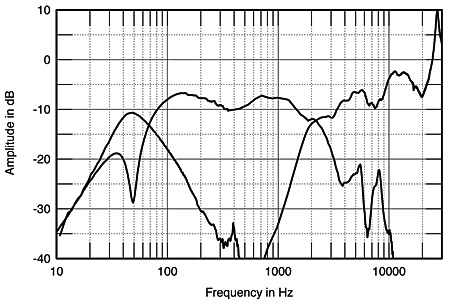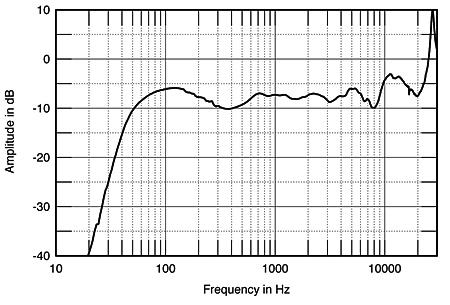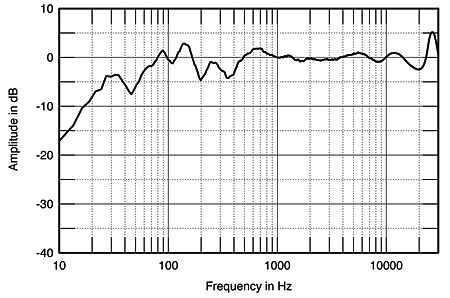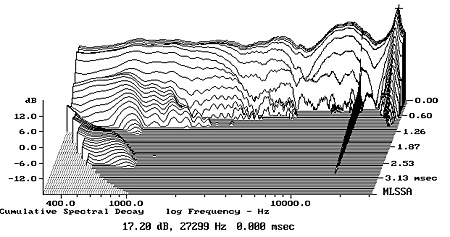| Columns Retired Columns & Blogs |
Monitor Audio Gold Signature GS10 loudspeaker Measurements
Sidebar 3: Measurements
The GS10's voltage sensitivity on its tweeter axis was to specification, at an estimated 88dB(B)/2.83V/m. The speaker's impedance remained above 6 ohms over most of the audioband, dropping to a minimum magnitude of 4 ohms at 190Hz (fig.1). The electrical phase angle varies considerably, but as always the most extreme angles occur when the magnitude is high, diminishing the difficulty of the loading. The shape of the magnitude trace suggests that the speaker will sound a bit forward, perhaps even bright, when used with tube amplifiers having a high source impedance.

Fig.1 Monitor Audio GS10, electrical impedance (solid) and phase (dashed). (2 ohms/vertical div.)
It is difficult to see at the scale these graphs are printed in the magazine, but there is a slight discontinuity in both impedance traces around 400Hz, suggesting the presence of some kind of cabinet resonance. (The larger discontinuity around 28kHz is due to the tweeter's fundamental dome resonance.) Examining the cabinet panels' vibrational behavior with a simple accelerometer did indeed uncover some strong resonances at 422 and 500Hz (fig.2), and listening to the cabinet walls with a stethoscope in the octave between 250 and 500Hz revealed strong cabinet resonances. Though it is unwise to predict the audible effects of such resonances, I did find that the attacks of the half-step–spaced mid-frequency tonebursts on my Editor's Choice CD (Stereophile STPH016-2) sounded a little blurred.

Fig.2 Monitor Audio GS10, cumulative spectral-decay plot calculated from the output of an accelerometer fastened to the center of the cabinet's side panel (MLS driving voltage to speaker, 7.55V; measurement bandwidth, 2kHz).
The saddle centered on 39Hz in the impedance-magnitude trace suggests that this is the tuning frequency of the 2"-diameter reflex port on the rear panel. The port's output, measured in the nearfield, is shown to the left of fig.3. It does peak between 40 and 50Hz, with a well-controlled rolloff above that region, without any midrange resonances evident. The woofer's output in fig.3 features the expected minimum-motion notch at 39Hz, and it crosses over to the tweeter at around 2.3kHz, a little lower in frequency than specified. The woofer's response has a couple of sharp spikes apparent in the two octaves above crossover, at 5.5 and 8.2kHz, but these are relatively well suppressed. The tweeter rolls in with what appears to be a third-order, 18dB/octave slope, and has a somewhat boosted output on-axis between 4 and 6kHz and in the top octave. Its fundamental dome resonance results in a sharp ultrasonic peak just above 27kHz, though this will be inaudible in itself.

Fig.3 Monitor Audio GS10, acoustic crossover on tweeter axis at 50", corrected for microphone response, with the nearfield responses of the port and woofer plotted below 450Hz and 300Hz, respectively.
Fig.4 shows how these individual responses add in the farfield on the tweeter axis. Other than a slight reticence in the midrange and a little too much energy in the top octave, the GS10 is impressively flat in the audioband. The low frequencies show the usual boost resulting from the nearfield measurement technique, suggesting that the speaker actually has a maximally flat woofer alignment. The GS10's anechoic output will extend down to 55Hz or so before the usual 24dB/octave reflex rolloff, but will be more extended in-room, of course.

Fig.4 Monitor Audio GS10, anechoic response on tweeter axis at 50", averaged across 30° horizontal window and corrected for microphone response, with the complex sum of the nearfield responses plotted below 300Hz.
On the face of it, the Monitor Audio's plot of lateral dispersion (fig.5) doesn't look promising. However, by comparison with fig.4, the off-axis flare coincides with the region where the on-axis response has a slight lack of energy. Similarly, the tweeter becomes increasingly directional above 10kHz, which will work against the top-octave boost on-axis. In all but very large rooms, the GS10 will tend to sound more neutrally balanced, at least above 10kHz. In the vertical plane (fig.6), the on-axis output doesn't change significantly between listener ear heights level with the top of the cabinet and the center of the woofer. A suckout develops in the crossover region above the cabinet, suggesting that tall stands will work better than short ones.

Fig.5 Monitor Audio GS10, lateral response family at 50", normalized to response on tweeter axis, from back to front: differences in response 90–5° off axis, reference response, differences in response 5–90° off axis.

Fig.6 Monitor Audio GS10, vertical response family at 50", normalized to response on tweeter axis, from back to front: differences in response 45–5° above axis, reference response, differences in response 5–45° below axis.
In my listening room, the Monitor Audio's 1/6-octave–smoothed, spatially averaged response at the listening position (fig.7) is extraordinarily smooth and flat above the lower-midrange region, where residual room effects still make their presence known. However, by comparison with fig.7 in my July review of the AAD Silver-1, which sounded neutrally balanced in my room, the GS10 has more energy apparent in the region between 2 and 8kHz. This might explain why I found its balance a little bright at times. The low frequencies start to roll out below 75Hz or so, but, like the AAD, are reinforced by a room mode in the 32Hz band.

Fig.7 Monitor Audio GS10, spatially averaged, 1/6-octave response in JA's listening room.
In the time domain, the GS10's step response on the tweeter axis (fig.8) reveals that the two drive-units are connected with the same positive acoustic polarity, but that the woofer's step very slightly lags that of the tweeter. (The samples were wired identically.) The optimal integration of the two units' outputs will thus occur just below the tweeter axis, confirming that taller stands will work better than short ones. (Monitor Audio's own stands are ideal, at 24.5" tall.) The speaker's cumulative spectral-decay plot (fig.9) is dominated by the ultrasonic tweeter resonance but is otherwise superbly clean.

Fig.8 Monitor Audio GS10, step response on tweeter axis at 50" (5ms time window, 30kHz bandwidth).

Fig.9 Monitor Audio GS10, cumulative spectral-decay plot at 50" (0.15ms risetime).
The Monitor Audio GS10's measured performance reveals excellent audio engineering and carefully optimized design.—John Atkinson
- Log in or register to post comments




































